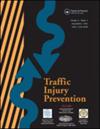Evaluating the effectiveness of safety countermeasures at highway–railway grade crossing based on a machine learning framework
IF 1.6
3区 工程技术
Q3 PUBLIC, ENVIRONMENTAL & OCCUPATIONAL HEALTH
引用次数: 0
Abstract
Objective
This research aims to cluster similar highway–railway grade crossings (HRGCs) to examine the safety countermeasures at HRGCs.
Methods
The methodology integrates inventory and collision data from Federal Railroad Association (FRA) data set during years 2010 to 2022 . The XGBoost and random forest (RF) algorithms are employed to identify influential collision severity factors. Then, the deep latent class analysis (DLCA) method is utilized on selected inventory factors as important features to cluster similar HRGCs. Afterward, collision modification factor (CMF) and standard error (SE) measures are computed for each countermeasure through collisions within each HRGC cluster.
Results
XGBoost successfully identified 20 important collision and inventory factors with importance levels exceeding 94%, such as the number of daily trains and the surface material. Then, the DCLA method achieved 4 distinct clusters optimized by high similarity within each cluster and significant independence among clusters. The effectiveness of countermeasures was computed in terms of CMF and SE. The CMF results demonstrated that bells achieved superior safety compared to other countermeasures in clusters with sharper track angles and high maximum train speeds. Implementing bells decreased collisions across Clusters 1 and 4, with reductions of 53% (CMF = 0.47) and 46% (CMF = 0.54), respectively.
Conclusions
The results highlight XGBoost’s capability to identify important collision and inventory factors, successfully uncovering 20 of the most important factors. The DCLA clustering method forms 4 distinct groups marked by substantial internal similarity within each cluster. This approach contributes to a clearer understanding of how each countermeasure impacts collision frequency. The findings highlight the varying effectiveness of different countermeasures across clusters, improving decision making for safety at HRGCs. The study highlights the efficacy of crossbucks in addressing safety concerns during moderate traffic conditions, particularly evident in environments with a highway speed limit between 100 and 125 mph. Additionally, bells demonstrate notable effectiveness in areas with sharper track angles.
基于机器学习框架评估公路-铁路平交道口安全对策的有效性。
研究目的本研究旨在对类似的公路-铁路平交道口(HRGCs)进行分组,以研究公路-铁路平交道口的安全对策:该方法整合了联邦铁路协会(FRA)2010 年至 2022 年数据集中的库存和碰撞数据。采用XGBoost和随机森林(RF)算法识别碰撞严重程度的影响因素。然后,利用深度潜类分析(DLCA)方法,将选定的库存因素作为重要特征,对相似的 HRGC 进行聚类。然后,通过每个 HRGC 聚类中的碰撞,计算出每种对策的碰撞修正系数(CMF)和标准误差(SE):XGBoost 成功识别了 20 个重要的碰撞和库存因素,其重要程度超过 94%,如每日列车数量和表面材料。然后,DCLA 方法通过各簇内的高相似性和簇间的显著独立性优化了 4 个不同的簇。根据 CMF 和 SE 计算了对策的有效性。CMF 结果表明,在轨道角度较大、列车最高速度较高的集群中,与其他对策相比,铃铛实现了更高的安全性。在第 1 和第 4 组群中,采用铃铛减少了碰撞,分别减少了 53% (CMF = 0.47) 和 46% (CMF=0.54):结果凸显了 XGBoost 识别重要碰撞和库存因素的能力,成功发现了 20 个最重要的因素。DCLA 聚类方法形成了 4 个不同的群组,每个群组内部具有很大的相似性。这种方法有助于更清楚地了解每种对策如何影响碰撞频率。研究结果凸显了不同群组中不同应对措施的不同效果,从而改善了高速公安全决策。研究强调了交叉路障在中等交通状况下解决安全问题的有效性,尤其是在高速公路限速为 100 到 125 英里/小时的环境中。此外,在轨道角度较急的区域,横档也显示出显著的效果。
本文章由计算机程序翻译,如有差异,请以英文原文为准。
求助全文
约1分钟内获得全文
求助全文
来源期刊

Traffic Injury Prevention
PUBLIC, ENVIRONMENTAL & OCCUPATIONAL HEALTH-
CiteScore
3.60
自引率
10.00%
发文量
137
审稿时长
3 months
期刊介绍:
The purpose of Traffic Injury Prevention is to bridge the disciplines of medicine, engineering, public health and traffic safety in order to foster the science of traffic injury prevention. The archival journal focuses on research, interventions and evaluations within the areas of traffic safety, crash causation, injury prevention and treatment.
General topics within the journal''s scope are driver behavior, road infrastructure, emerging crash avoidance technologies, crash and injury epidemiology, alcohol and drugs, impact injury biomechanics, vehicle crashworthiness, occupant restraints, pedestrian safety, evaluation of interventions, economic consequences and emergency and clinical care with specific application to traffic injury prevention. The journal includes full length papers, review articles, case studies, brief technical notes and commentaries.
 求助内容:
求助内容: 应助结果提醒方式:
应助结果提醒方式:


